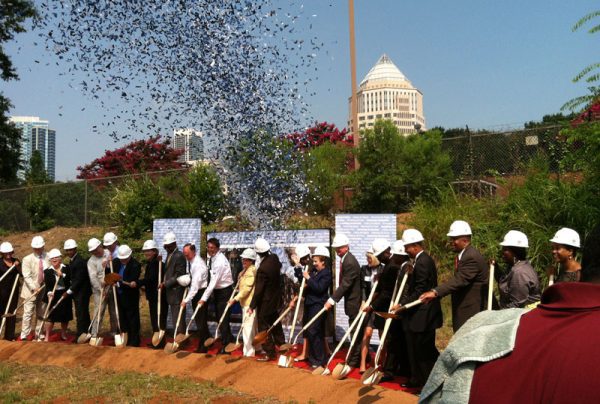City to work with owners of station-area properties

With encouragement from City Manager Ron Carlee, Charlotte’s planning department is taking more initiative in contacting property owners along the route of the city’s new light rail line and encouraging them to help the city achieve its vision for the corridor, Planning Director Debra Campbell told the city-county planning commission Monday.
Campbell spoke during a lengthy staff presentation and commission discussion about the department’s work on station area plans in the UNC Charlotte area. Planners are updating a 2007 University City Area Plan (download it here), because locations and names for some of the light rail stations have changed since that plan was adopted. The Blue Line Extension, under construction, will expand the city’s light rail corridor by 9.3 miles and 11 stations. It’s expected to be complete in 2017.
Want to know more about transit station plans?—The Charlotte-Mecklenburg Planning Department will hold public workshops on Dec. 10 and Feb. 11 to collect input on the three University City-area transit station area plans (University City Boulevard, McCullough and J.W. Clay Boulevard station areas). The Dec. 10 workshop will be 4:30-6:30 p.m. at Oasis Shriners building, 604 Doug Mayes Place, Charlotte. For more information click here. —The Charlotte Area Transit System (CATS) will hold a public meeting Dec. 5 to give an update on the Blue Line Extension project. That meeting will be 4:30-6:30 p.m. at Sugaw Creek Presbyterian Church, 101 W. Sugar Creek Road. |
The station area plan for the University City Boulevard Station is in the news because developers want to rezone 39 acres within a half-mile of the station for an auto mall, a collection of auto dealerships in one location. It’s a controversial proposal. City policy for areas within a half-mile of stations is for development that’s designed to encourage people to walk or bicycle, not drive. That means putting housing, shopping, restaurants and offices within an easy walk of each other. A cluster of auto dealerships, with large parking lots, doesn’t fit that pattern. Nevertheless, the planning staff and the Zoning Committee of the planning commission have recommended that the City Council approve the auto mall rezoning. The council vote is set for Dec. 16.
(To read more about the auto mall proposal, see “Key decision on auto mall rezoning is deferred,” and a related commentary, “Don’t derail transit areas with an auto mall.”)
Assistant Planning Director Ed McKinney told planning commissioners that planners are studying all the station areas along the Blue Line and will look toward possible rezoning of some sites to more transit-oriented zoning categories, especially for areas within a quarter mile of stations. One site, he said, is 60 undeveloped acres under one ownership, right at the University City Boulevard Station. “We’ve been in discussion over the past several months,” he said.
Campbell then told the commissioners that “what we’re hearing from the new city manager [Carlee began work in April] is that it’s OK to lead … to literally go out and negotiate with property owners. I think it’s a very, very new role for us.”
The goal, she said, is to give the city a more assertive, proactive role in implementing its plans, to encourage property owners not to “just do development, but do development that’s consistent with the vision.” In an interview after the commission meeting, Campbell said the new, more aggressive role is a change for Charlotte, where traditionally government has more “reactive.” She said planners, with the city’s Neighborhood and Business Services Department, had already talked to several property owners about the possibility of rezoning to more transit-supportive zoning categories. She said some owners wanted to know more; others believe the development market had not matured enough for them to build the more intensive, transit-friendly development.
She told the commissioners, “It’s a learning experience for us, but one we’re very excited about taking on.”
Charlotte planners sometimes encounter a disconnect between plans and zoning. In Charlotte, city plans are policy guidelines without force of law. The legal requirements for developing a piece of property are in the zoning ordinance, and are dictated by the way the property is zoned. One example of the disconnect between vision and zoning is a new apartment complex going up near the University City Boulevard transit station. Although multifamily development is encouraged at station areas, this complex will be surrounded with gates and have plenty of surface parking lots. At transit station areas planners would rather see development like the apartments and condos built in recent decades in uptown Charlotte, which front on streets with sidewalks. But the University City property had been zoned years ago for a conventional suburban-style, auto-oriented development. So the apartment project did not need a rezoning from the City Council.